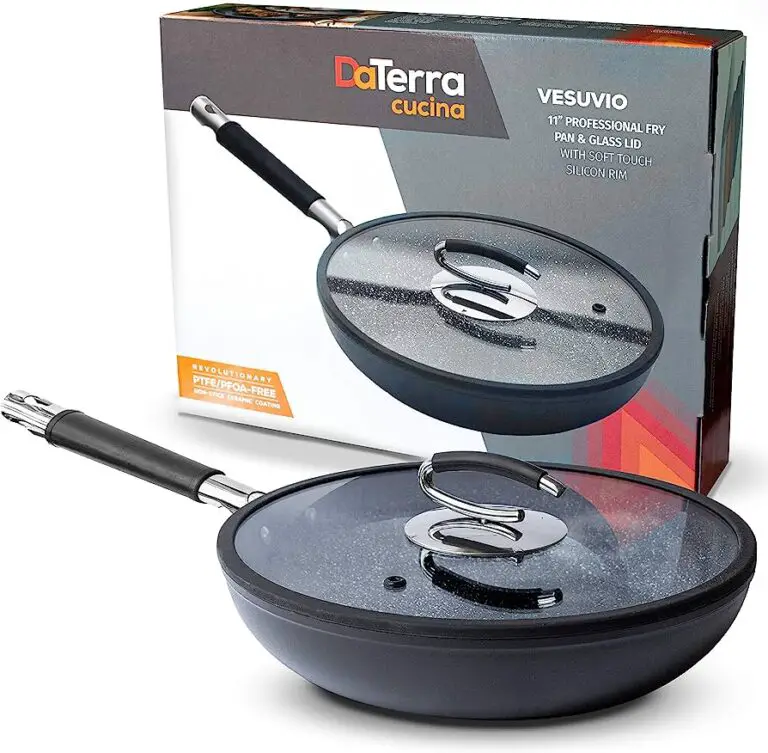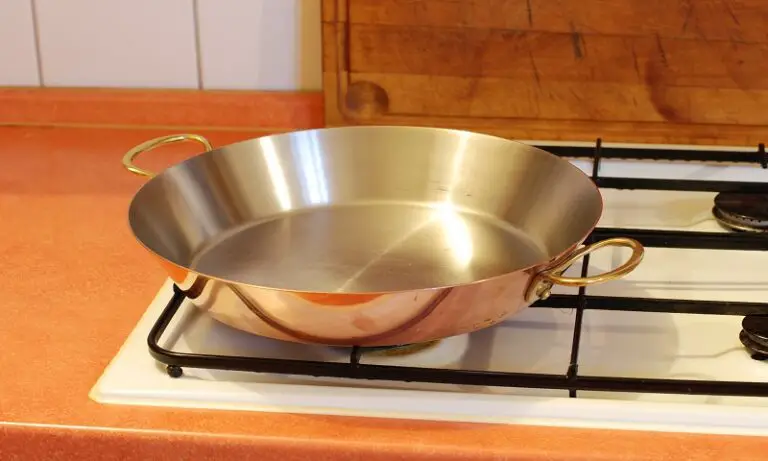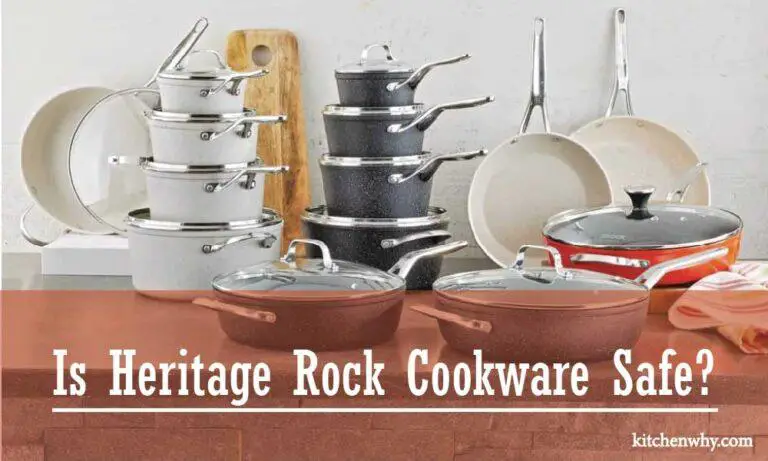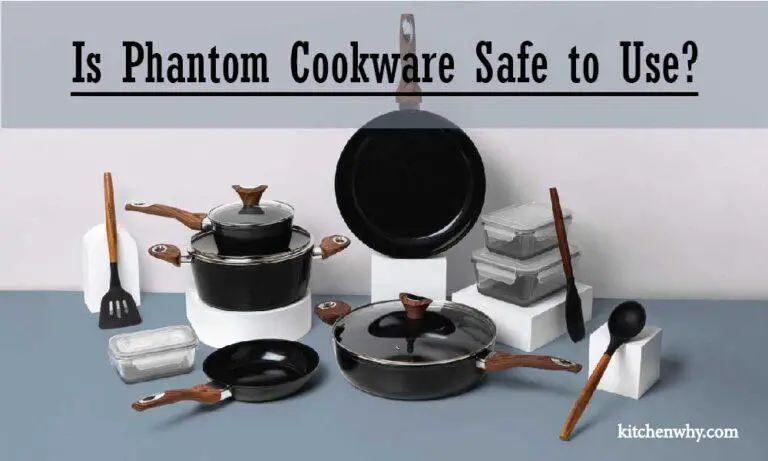Why are Frying Pans So Expensive? The Hidden Truth Unveiled!
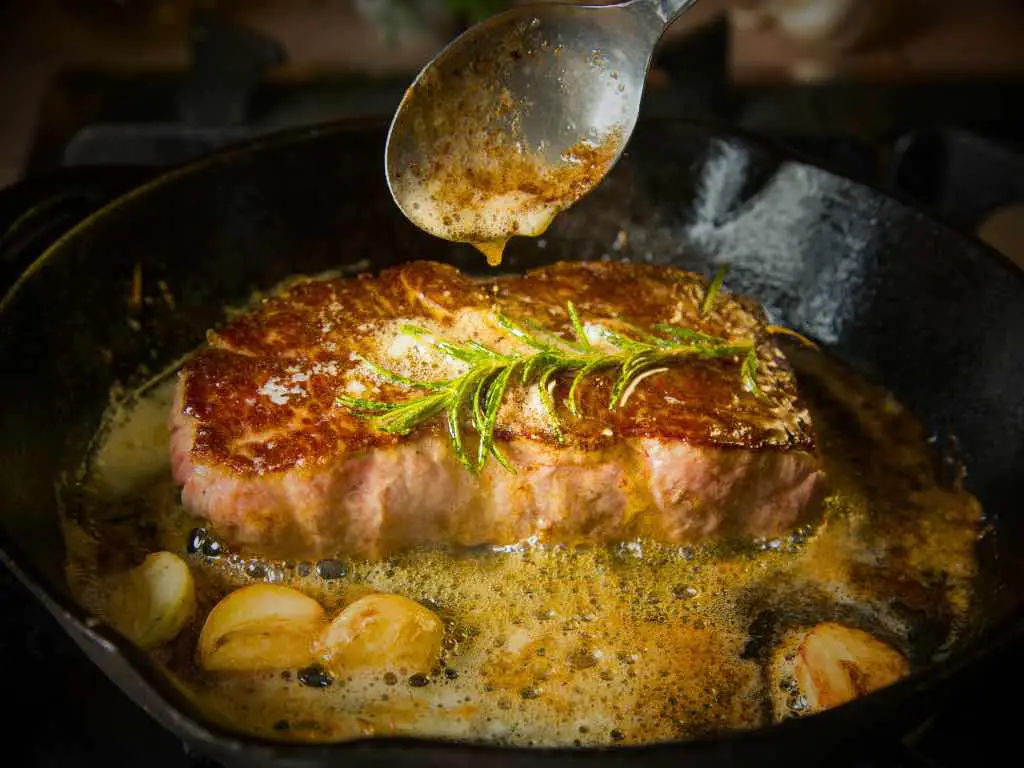
Frying pans are expensive due to the high-quality materials and advanced technology used in their production. They are made to withstand high heat and provide optimal cooking performance.
Additionally, the durability and longevity of frying pans contribute to their higher price point. Frying pans, an essential tool in every kitchen, play a crucial role in our daily cooking routines. A good frying pan can make a significant difference in the outcome of our culinary endeavors.
However, have you ever wondered why these humble cookware items often come with a hefty price tag? The answer lies in the craftsmanship and materials used in their construction. In this article, we will explore the reasons behind the seemingly high cost of frying pans, shedding light on the exceptional qualities that make them worth the investment. From their durability to the incorporation of cutting-edge technology, these factors contribute to the increased price of frying pans that deliver superior cooking performance. So, let’s dive into the world of frying pans and uncover the secrets behind their expense.
Why are Frying Pans So Expensive?
Frying pans can vary widely in price, and while some may seem expensive, there are several reasons that contribute to their costs:
- Materials: High-quality frying pans are often made from materials that conduct and distribute heat effectively, such as stainless steel, copper, or multi-ply constructions. These materials can be more expensive than basic aluminum pans, which affects the overall cost.
- Technology and Design: Some frying pans incorporate advanced technologies like non-stick coatings, induction compatibility, or heat-resistant handles. These features can increase manufacturing complexity and cost.
- Durability: Well-made frying pans are built to last. They may have reinforced coatings, better construction, and thicker materials, which can make them more durable and increase their price.
- Non-Stick Coatings: Frying pans with high-quality non-stick coatings often cost more due to the technology involved in creating a durable and safe non-stick surface. These coatings can also require more careful handling to maintain their effectiveness.
- Brand Reputation: Established brands with a history of producing reliable and high-quality cookware may command higher prices based on their reputation.
- Production Methods: Some frying pans are handcrafted or made using specialized manufacturing methods, which can add to their cost. Skilled labor and precision are often required for these processes.
- Heat Distribution: Even heat distribution is crucial for cooking, and some higher-priced frying pans are engineered to provide more consistent heat across the cooking surface.
- Induction Compatibility: Frying pans designed to work with induction cooktops require specific materials and construction, which can increase their cost.
- Specialized Use: Frying pans designed for specific tasks, such as woks, crepe pans, or grill pans, may be priced higher due to their unique design and functionality.
- Warranty and Customer Support: Some premium frying pans come with extended warranties or excellent customer support, which can contribute to their higher price point.
It’s important to note that while expensive frying pans can offer benefits in terms of performance, durability, and cooking experience, there are also reasonably priced options available that can provide satisfactory results for everyday cooking needs. Ultimately, the cost of a frying pan is often a reflection of the materials, craftsmanship, technology, and brand reputation associated with it.
The Rising Costs Of Materials And Manufacturing Processes
Frying pans, a kitchen essential and a cook’s best friend, are known for their versatility and durability. However, if you’ve ever gone shopping for one, you might have been taken aback by the seemingly high price tags. So why exactly are frying pans so expensive?
Let’s delve into the rising costs of materials and manufacturing processes that contribute to the increased price of these everyday cookware items.
Increasing Prices Of Raw Materials
- Stainless steel: With its resistance to corrosion and ability to evenly distribute heat, stainless steel is a popular material choice for frying pans. However, the price of stainless steel has been steadily increasing due to rising demand and production costs.
- Aluminum: Known for its excellent heat conductivity, aluminum is often used in the construction of frying pans. But the cost of this lightweight metal has also been on the rise, as global demand continues to grow.
- Copper: Revered by professional chefs for its exceptional heat conductivity, copper is a premium choice for frying pans. However, the scarcity of copper and the high cost of mining and processing the metal contribute to the elevated prices of copper pans.
Pricier Manufacturing Methods And Techniques
- Non-stick coatings: Non-stick frying pans coated with materials like teflon make cooking and cleaning a breeze. However, the manufacturing process involved in applying these coatings comes at a cost. The intricate nature of the process, coupled with the need for quality control, increases the overall price of non-stick pans.
- Multilayer construction: Some high-end frying pans boast a multilayered construction, with different metals bonded together. This combination enhances heat distribution and ensures durability. However, the complex manufacturing process required to create these layered pans requires precision and skilled craftsmanship, resulting in higher production costs.
- Eco-friendly practices: As environmental consciousness grows, manufacturers are adopting more sustainable practices. From using recycled materials to reducing energy consumption during production, these eco-friendly initiatives often come with a price tag. Manufacturers invest in these processes to align with consumer demands and ensure a greener future.
The rising costs of raw materials such as stainless steel, aluminum, and copper, coupled with pricier manufacturing methods like non-stick coatings, multilayer construction, and eco-friendly practices, contribute to the higher price points of frying pans. While investing in a quality frying pan might pinch your wallet initially, the long-term durability and performance justify the expense.
So the next time you cook up a storm in the kitchen, remember that every aspect of that frying pan’s creation has played a role in its price.
The Impact Of Brand Reputation And Quality
Frying pans, a staple in any kitchen, come in a wide range of prices. From budget-friendly options to high-end brands, you may find yourself wondering why some frying pans are so expensive. In this blog post, we’ll explore the impact of brand reputation and quality on the price of frying pans.
Established Brands And Their Higher Price Tags
- Brand recognition and trust: Established brands have built a reputation for quality and reliability over the years. Consumers are often willing to pay a premium for the assurance that comes with trusted brands.
- Extensive research and development: Well-known brands invest significant time and resources in research and development to create innovative designs and features that improve cooking performance. These costs are often reflected in the higher price of their frying pans.
- Longevity and durability: High-quality frying pans are built to last. Established brands often use durable materials and superior craftsmanship, resulting in pans that can withstand years of use without losing their effectiveness.
- Customer support and warranty: Reputable brands typically offer excellent customer support and warranty programs. This added value provides customers with peace of mind and justifies the higher price tag.
Quality Materials And Craftsmanship
- Superior materials: High-end frying pans are often made from premium materials such as stainless steel, copper, or cast iron. These materials distribute heat more evenly and offer superior conductivity, resulting in more precise cooking control.
- Expert craftsmanship: Expensive frying pans are often meticulously crafted, with attention to detail in their construction. From seamless design to sturdy handles and ergonomic features, the craftsmanship of these pans ensures a superior cooking experience.
- Advanced technologies: Some high-end brands incorporate cutting-edge technologies into their frying pans. Non-stick coatings infused with diamond or ceramic particles, for example, enhance the pan’s performance and longevity.
- Investment in quality control: Premium frying pan manufacturers have rigorous quality control processes in place to ensure that their products meet the highest standards. This attention to detail reduces the likelihood of defects and increases overall customer satisfaction.
By focusing on brand reputation and quality, it becomes clear why frying pans from established brands can command higher price tags. From the trust customers place in these brands to the use of superior materials and expert craftsmanship, the extra investment can often be justified.
So, the next time you see a pricey frying pan, remember that it’s more than just a cooking tool—it’s a reflection of the brand’s commitment to excellence.
Exploring The Role Of Innovation And Technology In Pricing
Why Are Frying Pans So Expensive
When it comes to buying a new frying pan, you may have noticed that the prices can be quite high. Have you ever wondered why? In this blog post, we will delve into the factors that contribute to the high costs of frying pans, particularly focusing on the role of innovation and technology in pricing.
Technological Advancements Leading To Higher Costs
In the ever-evolving world of cookware, technological advancements play a significant role in driving up the prices of frying pans. Here are a few key points to consider:
- Enhanced heating capabilities: Frying pans nowadays come with advanced heating technologies that distribute heat more evenly across the cooking surface. This ensures that your food cooks evenly, reducing the risk of burning or undercooking. Such features require specialized materials and manufacturing processes, which naturally drive up the cost of production.
- Non-stick coatings: Non-stick frying pans have revolutionized the cooking experience for many. These pans incorporate innovative coatings that prevent food from sticking, making cleaning a breeze. However, formulating and applying these coatings involves intricate processes, often utilizing expensive materials. Consequently, the cost of producing non-stick frying pans is significantly higher than their traditional counterparts.
- Durability and longevity: With advancements in metallurgy and engineering, frying pans have become more durable and long-lasting. Manufacturers invest in research and development to create materials that resist warping, withstand high temperatures, and minimize wear and tear. These technological improvements ensure that frying pans can withstand heavy use over an extended period, but they also contribute to their higher price tags.
Innovative Features And Benefits Justify The Price
While the cost of frying pans may seem steep, it is important to recognize the innovative features and benefits they offer. Here are a few reasons why the price may be warranted:
- Healthier cooking options: Some frying pans come equipped with features that promote healthier cooking. For example, certain models have ridges that allow excess fats and oils to drain away from the food, resulting in lower calorie intake. Other pans utilize materials that require less oil for cooking, reducing the overall fat content of your meals. These health-focused features add value to the pan and can justify the higher price.
- Versatility and convenience: Many modern frying pans are designed to be versatile, allowing you to cook a wide range of dishes with ease. From induction-compatible bases to detachable handles for oven use, these pans are built to accommodate various cooking styles and techniques. The added convenience and flexibility these innovations bring make them worth the investment.
- Ergonomic designs: Manufacturers now prioritize user comfort by incorporating ergonomic designs into frying pans. From heat-resistant handles to lightweight constructions, these features aim to improve your cooking experience. While these design elements may not directly impact the performance of the pan, they enhance your overall satisfaction and make the higher price more justifiable.
The high prices of frying pans can be attributed to the advancements in technology and innovation that have elevated the cooking experience. From improved heating capabilities to non-stick coatings and durability enhancements, these features have their own costs, resulting in a higher price point.
When evaluating the price of a frying pan, it is crucial to consider the added benefits and convenience that these innovations bring to the table.
Understanding The Influence Of Market Demand And Competition
Frying pans are a staple in every kitchen, but have you ever wondered why they can be quite expensive? From intricate designs to top-quality materials, there are various factors that contribute to the high price tags. In this blog post, we will delve into the world of frying pans and explore the reasons behind their price.
### understanding the influence of market demand and competition:
Supply and demand dynamics:
- The demand for frying pans is consistently high, as they are a fundamental tool in cooking. With the rise of cooking enthusiasts and the popularity of cooking shows, the demand for high-quality frying pans has surged.
- Manufacturers strive to meet this demand, but a limited supply of certain materials, such as copper or cast iron, can drive up the prices. The scarcity of these materials affects the overall cost of producing frying pans.
Competition among brands and pricing strategies:
- The market for frying pans is highly competitive, with numerous brands vying for customers’ attention. As a result, brands invest heavily in research and development to create innovative features and better performance, driving up production costs.
- Premium brands often position themselves as high-end options, focusing on quality craftsmanship and unique design elements. These factors contribute to the higher price range for their frying pans.
- Brand reputation and customer loyalty play a significant role in pricing strategies. Well-established brands with a strong following can charge more for their products based on their reputation alone.
- Some brands offer frying pans at lower price points, targeting budget-conscious consumers. To achieve this, cost-cutting measures like using less expensive materials or simpler manufacturing processes are employed.
The price of frying pans is influenced by a combination of market demand and competition. The high demand for quality frying pans, coupled with limited supply of certain materials, drives up manufacturing costs. Additionally, brand competition and pricing strategies also contribute to the varying price ranges.
Whether you opt for a premium brand or a more affordable option, understanding these market dynamics can help you make an informed purchasing decision. So, next time you see a frying pan with a hefty price tag, you’ll have a better understanding of why it costs a pretty penny.
Frequently Asked Questions Of Why Are Frying Pans So Expensive
Why Are Frying Pans So Expensive?
Frying pans can be expensive due to factors such as material quality, construction, and brand reputation. Higher priced pans are often made with premium materials like stainless steel or copper, which offer better heat conductivity and durability. Additionally, reputable brands invest in research and design, ensuring their products are built to last and deliver superior performance, hence commanding higher prices.
Conclusion
To sum up, the expensive price tags on frying pans can be attributed to several factors. The quality of materials used, such as copper and stainless steel, not only enhances durability but also facilitates even heat distribution for efficient cooking.
The innovative designs and ergonomic features of higher-end pans add to their overall cost. Additionally, the extensive research and development put into creating non-stick coatings that are safe and long-lasting contribute to the elevated prices. Moreover, reputable brands invest in rigorous quality control measures, ensuring that each pan meets stringent standards.
While it’s true that budget-friendly options are available, they may not offer the same level of performance and longevity. So, when investing in a frying pan, it’s essential to consider factors like cooking needs, durability, and the potential long-term savings it offers.
Ultimately, by understanding the reasons behind the high price range, consumers can make informed decisions and choose a frying pan that provides value for money and enhances their cooking experience.

